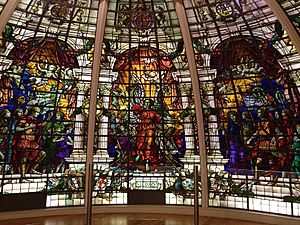Baltic Exchange Memorial Glass facts for kids
The Baltic Exchange Memorial Glass is a beautiful stained glass artwork. It was made by English artist John Dudley Forsyth. This special glass was put up in London in 1922. It was a way to remember the members of the Baltic Exchange who died in World War I. Today, you can see it at the National Maritime Museum in Greenwich.

Contents
What is the Memorial Glass?
The memorial glass is shaped like a half-dome. It's about 3 meters (10 feet) tall. It has 240 small glass pieces. There are also five rectangular windows. These windows show important ideas like Truth, Hope, Justice, Fortitude (strength), and Faith.
Symbols and Meanings
The glass is full of old symbols and religious signs. You can see a winged figure of Victory. She is stepping from a boat into a temple. There are also Roman soldiers and small angel-like figures called putti. A dove, which means peace, is also shown.
The artwork also includes the Royal coat of arms of the United Kingdom. You can also spot shields and badges. These represent different parts of the British Empire.
Remembering the Battles
Two parts of the glass list important battles from World War I.
- On the left side, you can see:
- Cambrai
- Mezières
- Arras and Lens
- Gallipoli
- Messines Ridge
- On the right side, you can see:
- Bethune
- Salonika
- Ypres and Loos
- Givenchy
- Passchendaele
How it Was Made
The glass was put together by a company called Lowndes & Drury. They worked at The Glass House, Fulham. General Sir Herbert Alexander Lawrence showed the glass to the public on June 1, 1922. A bishop named William Perrin then officially blessed it.
This special glass replaced clear windows and a dome. These had been part of the Baltic Exchange building since 1903. Before the glass was added, marble panels were put up. These panels listed the names of the 61 people who died. They were shown to the public on July 16, 1920.
Damage and Restoration
The memorial glass survived World War II without any harm. However, it was badly damaged in an event on April 10, 1992. Only 45 of the 240 glass panels were still okay. All the other panels and the five main windows were damaged.
Because of the damage, plans to rebuild the Baltic Exchange building were stopped. The old building was taken down in 1998. A new building, called 30 St Mary Axe (also known as the Gherkin), was built in its place. The Gherkin's glass roof is a nod to the old Baltic Exchange's dome.
With money from Swiss Re, the memorial glass was fixed. Glass experts from Goddard & Gibbs carefully restored it. Since 2005, the beautiful glass has been on display at the National Maritime Museum in Greenwich. The marble panels with the names of the dead were moved to the Baltic Exchange's new office at 38 St Mary Axe.

